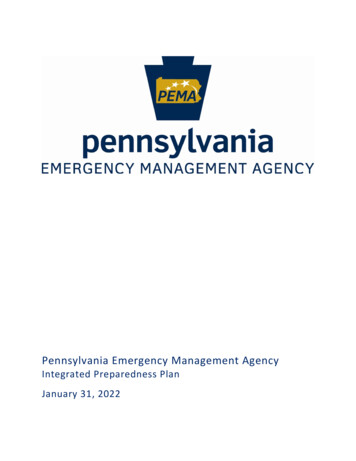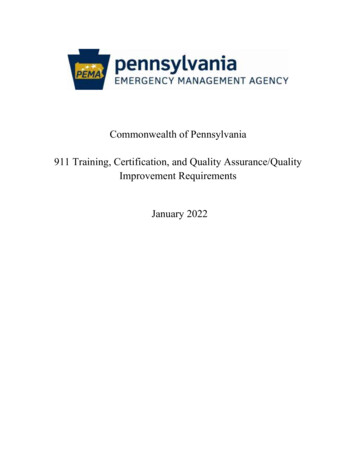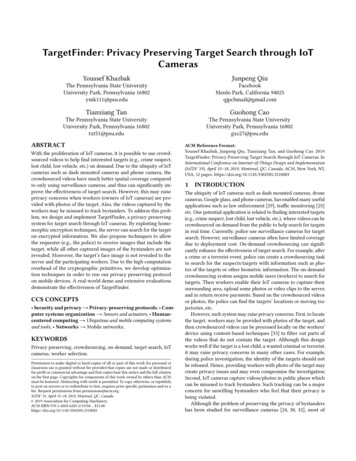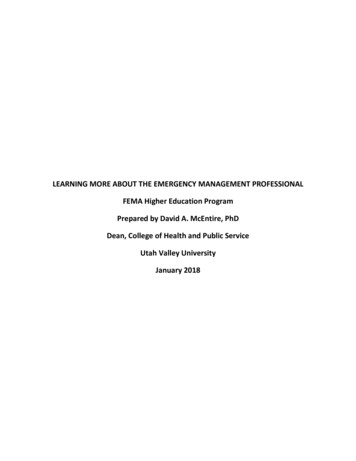
Transcription
Pennsylvania Emergency Management AgencyIntegrated Preparedness PlanJanuary 31, 2022
This page intentionally left blank.
INTEGRATED PREPAREDNESS PLANNING TEAMTeam LeadPlanning, NIMS, THIRA/SPR POC:Kirsten CohickBureau Director – Planning, Training, Exercise1310 Elmerton AveHarrisburg, PA 17110717-651-2723kcohick@pa.govMichael GossEmergency Management Specialist1310 Elmerton AveHarrisburg, PA 17110717-346-3103 (office)MicGoss@pa.govTraining & Exercise SupervisorRecovery & Mitigation POC:Reggie GodfreySupervisor (PEMA)1310 Elmerton AveHarrisburg, PA 17110717-651-2714rgodfrey@pa.govStephen BekanichDeputy Director for Recovery(PEMA)1310 Elmerton AveHarrisburg, PA 17110717-651-2231 (office)SBekanich@pa.govTraining POC:Hazard Analysis/Risk Assessments POC:Andy CaprioState Training Officer (PEMA)1310 Elmerton AveHarrisburg, PA 17110717-651-2256 (office)LCaprio@pa.govThomas HughesEmergency Management Supervisor(PEMA)1310 Elmerton AveHarrisburg, PA 17110717-651-2126 (office)THughes@pa.govExercise POC:Kamie HughesState Exercise Officer (PEMA)1310 Elmerton AveHarrisburg, PA 17110717-651-2287 (office)KamHughes@pa.gov1
PURPOSEThe purpose of the Pennsylvania Emergency Management Agency (PEMA) Integrated PreparednessPlan (IPP) – formerly known as the Multiyear Training and Exercise Plan (MYTEP) – is to document theprocess necessary to strengthen the core capabilities that are deemed essential in preventing,protecting against, mitigating the effects of, responding to, and recovering from threats and hazards.PEMA’s Training and Exercise Program employs a progressive approach that combines all-hazardplanning, trainings, and realistic exercises to enhance Pennsylvania’s overall preparedness capabilities.The IPP displays the preparedness activities of PEMA and its partners for 2022-2024. This plan reducesthe duplication of efforts by promoting communication and coordination amongst partners betweenstate agencies, in the counties, and throughout the region.Maintenance & ReviewPEMA is the primary agency responsible for providing direction and oversite of the Commonwealth’sIPP. A major review and update to the IPP occurs annually during the Integrated Preparedness PlanWorkshop (IPPW). The IPP is a dynamic document and is updated to reflect changing needs andpriorities. PEMA has transitioned the IPP calendar to an online calendar, located on PEMA’s website.This ensures that the most up-to-date information is available to all stakeholders at any given time.Integrated Preparedness Plan Workshop (IPPW)Each year, an IPPW is held to review and update PEMA’s IPP. In 2021, the workshop was held onDecember 14th. The IPPW provides a collaborative environment where Pennsylvania jurisdictional,non-profit, and private sector partners can meet and collaborate on plans to enhance theCommonwealth’s preparedness. The review and update process for the IPP consists of the followingthree objectives:1. Identify or validate the primary threats and hazards with the potential to impactPennsylvania.2. Identify the FEMA-designated and state leadership priority areas and core capabilitiesessential to combatting the identified threats and hazards; and3. Outline the cycle of preparedness activities that will provide the most value instrengthening the identified priority areas and core capabilities.2
Top Threats and HazardsAs part of the review of the IPP for 2022-2024, the Integrated Preparedness Plan Planning Group(IPPPG) identified the top potential threats and hazards that have the ability to impact Pennsylvania.To identify the threats and hazards, the IPPPG considered many sources including the PennsylvaniaHazard Mitigation Plan, the annual Threat and Hazard Identification and Risk Assessment (THIRA), andlocal, national, and global historical events.Threat and hazard identification is important as it allows PEMA to focus its preparedness efforts on theincidents and events most likely to occur or be most severe. In addition, this version of the plan willincorporate climate change impacts as a priority area for Pennsylvania. Figure 1 below demonstratesthe identified threats and hazards perceived to be a top priority for Pennsylvania (in no particularorder).Figure1 (Source:PA State Hazard Mitigation Plan)NaturalHazardsCoastal ErosionDroughtEarthquakeExtreme TemperatureFlood, Flash Flood, Ice JamHailstormHurricane, Tropical Storm,Nor'easterInvasive Species Technological Building and StructureCollapseDam FailureLevee FailureCyber-terrorismNuclear IncidentUtility InterruptionConventional Oil and Gas wellsGas and liquid pipelinesUnconventional oil and gas wellsHazardous materials release LandslideLightning StrikePandemicRadon ExposureSubsidence, SinkholeTornado, WindstormWildfireWinter StormHuman - Caused Incident Civil DisturbanceMass Food/Animal FeedContaminationOpioid Addiction ResponseTerrorism/Domestic ViolentExtremismTransportation AccidentUrban Fire and ExplosionCoal MiningFigure 13
Critical Infrastructure and Key Resources (CIKR)PEMA is committed to preserving the physical, psychological, and economic safety and securityof the Commonwealth, its residents, and its visitors. The IPPPG recognizes that Pennsylvaniacontains Critical Infrastructure and Key Resources (CIKR) that may be at greater risk of beingtargeted or harmed by threats and hazards. It is essential to incorporate CIKR into the planning,training, and exercise process. The vast majority of CIKR are privately owned and operated;therefore, the private sector must be included in the preparedness process to effectivelymanage real-world emergencies. Figure 2 below displays both Critical Infrastructure and MassGatherings and Special Events specific to Pennsylvania that may be especially vulnerable tothreats and hazards (in no particular order):Critical Infrastructure PipelinesSchoolsRoadsRail RoadsLevees / DamsEmergency Services FacilitiesOther Government FacilitiesWater / Waste-WaterTreatment FacilitiesElectric/Power stations & gridsPower PlantsMass Gatherings and Special Events Groundhog’s Day – Punxatawney, PASporting Events in Pittsburgh,Philadelphia, and State CollegeLittle League World Series –Williamsport, PATall Ships – Erie, PAGubernatorial InaugurationsPolitical ConventionsClean Energy Ministerial – Pittsburgh,PA (September 21-23, 2022)Figure 24
Priority Areas and Core CapabilitiesThe National Preparedness Goal has established 32 core capabilities that are deemed critical elementsnecessary to achieve and maintain a comprehensive level of preparedness. The core capabilities areorganized by the five emergency management mission areas: prevention, protection, mitigation,response, and recovery.FEMA, as part of the Emergency Management Performance Grant (EMPG), has designated five nationalpriority areas for improvement as they relate to emergency management capabilities. Each priorityarea has a list of associated core capabilities. It is recommended under the EMPG that training andexercise programs increase capability for high-priority core capabilities with low capability levels,validate capability levels, and maintain and/or sustain current capabilities. Below are the fivedesignated priority areas for 2021* with their associated core capabilities:1. Catastrophic Disaster Housing Housing Planning Situational Assessment Physical Protective Measures2. Resilient Communications Operational Communications Planning Public Information and Warning Operational Coordination Intelligence and Information Sharing Cybersecurity Physical Protective Measures Long-Term Vulnerability Reduction Risk and Disaster Resilience Assessment Threats and Hazards Identification Infrastructure Systems3. Disaster Financial Management Planning Risk Management for Protection Programs and Activities Risk and Disaster Resilience Assessment Community Resilience Economic Recovery4. Evacuation Plan/Annex Planning5
Risk Management for Protection Programs and ActivitiesRisk and Disaster Resilience AssessmentThreats and Hazards IdentificationOperational CoordinationLong-term Vulnerability Reduction5. Logistics – Distribution Management Planning Logistics and Supply Chain Management Supply Chain Integrity and Security* FEMA has yet to release the EMPG priority areas for 2022. These will be incorporated into thedocument as soon as that information is released.Commonwealth’s Priority Core CapabilitiesThe IPPPG conducted an analysis of After-Action Reports (AARs), the Threat and Hazard Identificationand Risk Assessment and Stakeholder Preparedness Review (THIRA/SPR), as well as solicited county,task force, and state agency input during the IPPW to determine which of the core capabilities weremost essential to focus on during the upcoming preparedness cycle. Figure 3 shows the corecapabilities that were identified the most frequently through various inputs identified above and willbe the Commonwealth’s focus for 2022-2024:Mass Search and Rescue OperationsOperational CommunicationsPublic Health, Healthcare, & EMSPublic Information & WarningOperational CoordinationCybersecuritySituational AssessmentLogistics & Supply Chain ManagementPlanningEnvironmental Response, Health & SafetyMass Care ServicesAs identified in PA SPR – overalltrends/mentionsAs most frequently identified incounty-submitted IPPsFigure 3The following section provides a brief description of the essential core capabilities and any identifiedpreparedness activities that would support the strengthening of the associated capability. Someactivities may support multiple core capabilities and may be listed as such. It is important to also notethat the preparedness activities identified are not an all-inclusive list, and there are other activities thatmay support the associated capabilities as well. Planned activities can be found on the IntegratedPreparedness Calendar. For the purposes of this plan, “preparedness activities” encompass Planning,Organization, Equipment, Training, and Exercise (POETE) elements.6
Operational CoordinationAccording to the National Preparedness Goal, the Operational Coordination core capability establishesand maintains “a unified and coordinated operational structure and process that appropriatelyintegrates all critical stakeholders and supports the execution of core capabilities.”Supporting Preparedness Activities: G – 191, ICS/EOC Interface G – 205, Recovery from Disaster: The Local Government Role G – 402, ICS Overview for Executive/Senior Officials G/E – 2300, Intermediate Emergency Operations Center Functions ICS – 300, Intermediate ICS for Expanding Incidents ICS – 400, Advanced ICS for Command and General Staff IS – 100, Introduction to the Incident Command System (ICS) IS – 200, ICS for Single Resource and Initial Action Incidents IS – 700, Introduction to the National Incident Management System (NIMS) IS – 800, Introduction to National Response Framework (NRF) IS – 2200, Basic Emergency Operations Center Functions MGT – 346, Emergency Operation Center (EOC) Operations for All-Hazards Events O – 305, Type 3 All-Hazards Incident Management Team PEMA’s May 2022 Full-Scale Exercise National Qualification System/ PEMA Qualification System implementation ESF 13/Civil Unrest Annex Workshop (State Agencies) FEMA Virtual Tabletop Series (VTTX) Rescue Task Force classesCybersecurityAccording to the National Preparedness Goal, the Cybersecurity core capability seeks to “protectagainst damage to, the unauthorized use of, and/or the exploitation of (and, if needed, the restorationof) electronic communication systems and services (and the information contained therein).Cybersecurity has become extremely important as many of our emergency functions rely on cybersystems, networks, and assets.”Supporting Preparedness Activities: AWR – 136, Essentials of Community Cybersecurity AWR – 384-W, Cyber Identity and Authentication E – 553, Resilient Accord Cybersecurity Planning MGT – 384, Community Preparedness for Cyber Incidents MGT – 385, Community Cybersecurity Exercise Planning MGT – 452, Physical and Cybersecurity for Critical Infrastructure MGT – 465, Recovering from Cybersecurity Incidents PER– 256, Comprehensive Cyberterrorism Defense (CCD)7
PER – 257, Cyberterrorism First Responder (CFR)PA Cyber Incident Annex to the CEOPPA Cyber Incident Annex Tabletop ExerciseSituational AssessmentSituational Assessment, per the National Preparedness Goal, provides “all decision makers withdecision-relevant information regarding the nature and extent of the hazard, any cascading effects,and the status of the response.”Supporting Preparedness Activities: E – 143, Advanced Situational Awareness and Common Operating Picture E – 190, ArcGIS for Emergency Managers E – 550, Continuity of Operations Planning E – 948, Situational Awareness and Common Operating Picture E – 964, Situation Unit Leader G – 557, Rapid Needs Assessment WebEOC training PEMA CRCC Situational Awareness Section Training (PEMA staff only) PEMA’s May 2022 Full-Scale Exercise Dataminr Software Keystone Emergency Management System (KEMS) developmentOperational CommunicationsAccording to the National Preparedness Goal, the Operational Communications core capability seeks to“ensure the capacity for timely communications in support of security, situational awareness, andoperations by all means available, among and between affected communities in the impact area and allresponse forces.”Supporting Preparedness Activities: AWR – 221-W, Principles of Effective Campus Public Emergency Communications AWR – 329, Leveraging Tools for Coordinated Community Disaster Communications E/L – 969, NIMS ICS All-Hazards Type III Communications Unit Leader (COML) EOC Radio Drills G – 272, Warning Coordination G-291, Joint Information System/Center Planning for Tribal, State, and Local PublicInformation Officers IS – 242, Effective Communication IS – 247, Integrated Public Alert and Warning System (IPAWS) IS – 251.a, Integrated Public Alert and Warning System (IPAWS) for AlertingAuthorities IS-951 DHS Radio Interoperability8
PEMA’s May 2022 Full-Scale ExerciseEmergency Support Function 2 Workshop – CommunicationsPA Tactical Interoperable Communications Plan (TIC-P)PEMA Communications PlanP25 System rolloutSEVAN System Upgrade/ReplacementNAWAS/PAWASPublic Information and WarningAccording to the National Preparedness Goal, the Public Information and Warning core capability seeksto “deliver coordinated, prompt, reliable, and actionable information to the whole community usingclear, consistent, accessible, and culturally and linguistically appropriate methods to effectively relayinformation regarding any threat or hazard and, as appropriate, the actions being taken and theassistance being made available.”Supporting Preparedness Activities: E – 388, Advanced Public Information Officer E – 389/393/394, Master Public Information Officer E/L – 105, Public Information and Warning E/L – 952, NIMS/ICS All-Hazards Public Information Officer Course G – 272, Warning Coordination G – 290/289/291, Basic Public Information Officer Course (G – 290)/PublicInformation Officer Awareness Course (G – 289)/JIS/JIC Planning for Tribal, State,and Local PIOs (G –291) IS – 29, Public Information Officer Awareness IS – 42, Social Media in Emergency Management IS – 242, Effective Communication IS – 247, Integrated Public Alert and Warning System (IPAWS) IS – 248, Integrated Public Alert and Warning System (IPAWS) for the AmericanPublic IS – 251, Integrated Public Alert and Warning System (IPAWS) for AlertingAuthorities MGT – 318, Public Information in an All-Hazards Incident MGT– 902, Managing Public Information for All Hazards Incidents PER – 304, Social Media Platforms for Disaster Management PER – 343, Social Media Engagement Strategies PER – 344, Social Media Tools and Techniques Mesonet & Alerting Tool System Updates9
Public Health, Healthcare, and Emergency Medical ServicesAccording to the National Preparedness Goal, the Public Health and Medical Services core capabilityseeks to “provide lifesaving medical treatment via emergency medical services and related operationsand avoid additional disease and injury by providing targeted public health and medical support andproducts to all people in need within the affected area.”Supporting Preparedness Activities: AWR – 111, Basic Emergency Medical Services Concepts for Chemical, Biological,Radiological, Nuclear, and Explosive (CBRNE) Events AWR – 314, Medical Countermeasures for Public Health Emergencies AWR – 314-W, Medical Countermeasures Awareness for Public Health Emergencies AWR – 341, Disaster Preparedness for Healthcare Organizations within theCommunity Infrastructure AWR – 900, Framework for Healthcare Emergency Management IS – 520, Introduction to Continuity of Operations Planning for Pandemic Influenzas IS – 522, Exercising Continuity Plans for Pandemics MGT – 319, Medical Countermeasures: Points of Dispensing (POD), Planning andResponse MGT – 341, Disaster Preparedness for Healthcare Organizations within theCommunity Infrastructure MGT – 403, Response Planning for People with Access Functional Needs in RuralCommunities MGT – 409, Community Healthcare Planning and Response to Disasters MGT– 901, Healthcare Leadership for Mass Casualty Incidents PER – 211, Medical Management of Chemical, Biological, Radiological, Nuclear, andExplosive (CBRNE) Events PER – 320, Personal Protective Measures for Biological EventsMass Search and Rescue OperationsThe National Preparedness Goal defines the core capability of Mass Search and Rescue Operations asdelivering “traditional and atypical search and rescue capabilities, including personnel, services,animals, and assets to survivors in need, with the goal of saving the greatest number of endangeredlives in the shortest time possible.”Supporting Preparedness Activities: E/L-0986, ICS All-Hazards Air Support Group Supervisor E/L-0987, ICS All-Hazards Introduction to Air Operations O-305, All-Hazard Incident Management Team O – 322, Incident Command for Structural Collapse Incidents PER – 213, Wide Area Search S – 470, Air Operations Branch Director10
USCG – Basic Inland SAR Course (BISC)USCG – Inland SAR Planning Course (ISPC)PEMA’s May 2022 Full-Scale ExerciseESF 9 Workshop – Search and Rescue (State Agencies)State Incident Management TeamSwiftwater Rescue Teams (statewide)Helicopter Aquatic Rescue Team (HART)Transitioning of in-state USAR system to NIMS-Typing GuidelinesLogistics and Supply Chain ManagementThe Logistics and Supply Chain Management core capability aims to “deliver essential commodities,equipment, and services in support of impacted communities and survivors, to include emergencypower and fuel support, as well as the coordination of access to community staples. Synchronizelogistics capabilities and enable the restoration of impacted supply chains.”Supporting Preparedness Activities: E-288, Local Volunteer and Donations Management E-967, NIMS ICS All-Hazards Logistics Section Chief Course E-968, NIMS ICS All-Hazards Logistics Section Chief Train-the-Trainer IS-026, Guide to Points of Distribution IS-245.a, Introduction to the Federal Priorities and Allocations System IS-288.a, The Role of Voluntary Organizations in Emergency Management L – 660, Staging Area Manager FEMA Virtual Supply Chain Course (currently only a pilot) PEMA CRCC Logistics training (PEMA Staff only) PEMA’s May 2022 Full-Scale Exercise ESF 7 Workshop – Logistics Management and Resource Support (State Agencies) PA & County Distribution Management Plans PA Business EOC Dashboard Pennsylvania Road Closure Framework Pennsylvania Travel Restriction & Ban FrameworkPlanningThe National Preparedness Goal defines the core capability of Planning as conducting “a systematicprocess engaging the whole community, as appropriate, in the development of executable strategic,operational, and/or tactical-level approaches to meet defined objectives.”Supporting Preparedness Activities: AWR – 356, Community Planning for Disaster Recovery E – 103, Planning: Emergency Operations E – 237, Planning Process Theory and Application11
E – 962, NIMS ICS All-Hazards Planning Section Chief CourseIS – 011.a, Animals in Disasters: Community PlanningIS – 235.c, Emergency PlanningMGT – 360, Incident Command: Capabilities, Planning, and Response Actions for AllHazardsMGT – 418, Readiness: Training Identification and Preparedness PlanningMGT – 460, Planning for Disaster Debris ManagementPennsylvania Climate Leadership AcademyPEMA’s May 2022 Full-Scale ExerciseElection-Related Exercises and Planning Efforts (Statewide)Winter Weather & Road Closure/Ban Framework Workshop (State Agencies)Pennsylvania Response Incident Support Manual (PRISM)Special and Large Events Planning & ExercisesEnvironmental Response/Health and SafetyAccording to the National Preparedness Goal, the purpose of the Environmental Response/Health andSafety core capability is to “conduct appropriate measures to ensure the protection of the health andsafety of the public and workers, as well as the environment, from all-hazards in support of responderoperations and the affected communities.”Supporting Preparedness Activities: AWR – 118, Biological Incidents Awareness AWR – 358, Hazardous Materials Awareness PER – 272, Hazardous Materials Technician PER – 322, Hazardous Materials Operations Nuclear Power Plant Plume Exercise PEMA HAZMAT Exercises County Hazardous Materials Response TeamsMass Care ServicesThe core capability titled Mass Care Services, per the National Preparedness Goal, provides “lifesustaining and human services to the affected population, to include hydration, feeding, sheltering,temporary housing, evacuee support, reunification, and distribution of emergency supplies.”Supporting Preparedness Activities: E – 418, Mass Care - Emergency Assistance Planning and Operations E – 419, Mass Care - Emergency Assistance Shelter Field Guide Training for Statesand Local Communities G – 108, Community Mass Care and Emergency Assistance IS – 405, Mass Care/Emergency Assistance Overview American Red Cross – Shelter Fundamentals12
Methodology and TrackingAll preparedness activities adhere to the current guidelines and regulations of the EMPG whereverrequired. In addition, the Commonwealth exercise program seeks to be Homeland Security Exerciseand Evaluation Program (HSEEP)- compliant to ensure a consistent approach to planning, conducting,and evaluating exercise activities as well as implementing improvement planning. According to HSEEP,exercise priorities and objectives should be designed with an increasing level of complexity over time.Figure 4 below demonstrates the HSEEP progressive approach.Figure 413
Training and Exercises RequirementsPEMA is a recipient of EMPG funding. FEMA requires recipients to prioritize grant funding todemonstrate how EMPG Program-funded investments support closing capability gaps or sustainingcapabilities identified in the THIRA/ SPR process and other relevant information sources, such as: 1)AARs following exercises or real-world events; 2) audit and monitoring findings; 3) Hazard MitigationPlans; and/or 4) other deliberate planning products. Each jurisdiction receiving EMPG funds mustadhere to the following minimum training & exercise-related requirements, as outlined in the FEMAFederal Grants Preparedness Manual (Appendix H):1. EMPG-funded recipients and subrecipients are required to implement NIMS. EMPG-fundedpersonnel must take the following NIMS courses: IS-100, IS-200, IS-700, IS-800 AND either theFEMA Professional Development Series (PDS) or the Emergency Management ProfessionalProgram Basic Academy.2. Develop and maintain a progressive exercise program that aligns with the HSEEP.3. Complete an Integrated Preparedness Plan, due by January 31 annually.4. Complete a THIRA every three years and an SPR annually, each to be annually submitted byDecember 31.5. Beginning in FY 2022, implement the National Qualification System (NQS) or NQS-based system.Preparedness Activity ConsiderationsThe IPP was developed through an extensive data gathering process to adequately capture theemergency management preparedness priorities of the Commonwealth. The preparedness prioritieswere compiled from many sources, including: federal grant program priority areas; PEMA leadershippriorities; the Commonwealth’s and Task Forces’ THIRA/SPR submissions; stakeholder input; and AfterAction Reviews/Improvement Plans (AAR/IP) from previous exercises.In 2021, Task Forces and state agencies identified their respective planning, organization, equipment,training, and exercise needs during the annual THIRA & SPR process. An IPPW was held at PEMAHeadquarters in Harrisburg on December 14, 2021. Participants had the option of participating eithervirtually or in-person due to the ongoing COVID pandemic.14
Commonwealth of Pennsylvania Preparedness Priorities for 2022-2024Based on the above-mentioned considerations, the Commonwealth has identified the followingpriorities as the focus for the multi-year cycle of preparedness (in no particular order): Incorporating Climate Adaptation into Preparedness Activities Work to Standardize Special Teams to National Standards Statewide Develop or Update Supporting Plans to CEOPo Aviation Annexo Distribution Management Plano Search & Rescue Plan Enhancing Cybersecurity Enhancing the Protection of Soft Targets/Crowded Places Enhancing Information and Intelligence Sharing and Analysis Combatting Domestic Violent Extremism Addressing Emergent Threats Adapting to the Post-Pandemic Environment Continued Development and Use of WebEOC Capabilities &Applications Statewide Utilization & Monitoring of Social Media/ Situational Assessment Whole Community Preparedness Sustainment of the Emergency Management Programo PEMA Qualification System/NQS Implementationo Increasing the Availability of Training & ExerciseOpportunities(particularly ICS, AHIMT, and Position-Specific) Resilient CommunicationsPEMA LeadershipPrioritiesHSGP NationalPrioritiesCommonlyIdentified inSPRFEMA/PAAgreed-UponEMPGPriorities15
Appendix A - AcronymsAbbreviationTermAARAfter Action ReportAHIMTAll-Hazard Incident Management TeamCBRNEChemical, Biological, Radiological, Nuclear, ExplosivesCEOPCommonwealth Emergency Operations PlanCERTCommunity Emergency Response TeamCIKRCritical Infrastructure Key ResourcesCRCCCommonwealth Response Coordination CenterEMPGEmergency Management Performance GrantEOCEmergency Operations CenterFEFunctional ExerciseFSEFull Scale ExerciseHazMatHazardous MaterialsHHSHealth and Human ServicesHSEEPHomeland Security Exercise Evaluation ProgramICSIncident Command SystemIPImprovement PlanIPPIntegrated Preparedness PlanIPPPGIntegrated Preparedness Plan Planning GroupIPPWIntegrated Preparedness Plan WorkshopISIndependent StudyJICJoint Information CenterJISJoint Information System16
LMSLearning Management SystemMAAMutual Aid AgreementNIMSNational Incident Management SystemNRFNational Response FrameworkPEMAPennsylvania Emergency Management AgencyPODCommodity Point of Distribution /Medical Point of DispensingRWEReal World EventTHIRA/SPRTTXThreat and Hazard Identification and Risk Assessment/ StakeholderPreparedness ReviewTable Top ExerciseVTTXVirtual Table Top ExerciseUASIUrban Area Security Initiative17
Appendix B - Key TermsCritical Infrastructure and Key Resources (CIKR) - Any system or asset vital to Pennsylvaniawhose incapacity or destruction would cause a devitalizing impact on physical, psychological, oreconomical security, public health or safety or any combination thereof.Core Capabilities – Thirty-two (32) distinct critical elements necessary to achieve the NationalPreparedness Goal.Exercise - An instrument to train for, assess, practice, and improve performance in prevention,protection, mitigation, response, and recovery capabilities in a risk-free environment. Exercisescan be used for testing and validating policies, plans, procedures, training, equipment, andinteragency agreements; clarifying and training personnel in roles and responsibilities; improvinginteragency coordination and communications; improving individual performance; identifyinggaps in resources; and identifying opportunities for improvement.Homeland Security Exercise and Evaluation Program (HSEEP) - A program that provides a set ofguiding principles for exercise programs, as well as a common approach to exercise programmanagement, design and development, conduct, evaluation, and improvement planning.Improvement Plan (IP) - The IP identifies specific corrective actions, assigns them to responsibleparties, and establishes target dates for their completion. The IP is developed in conjunction withthe After-Action Report.Incident Command System (ICS) – A management system designed to enable effective andefficient domestic incident management by integrating a combination of facilities, equipment,personnel, procedures, and communications operating within a common organizationalstructure.Progressive Approach - A progressive approach designated by the Homeland Security Exerciseand Evaluation Program that includes the use of various exercises aligned to a common set ofexercise program priorities and objectives with an increasing level of complexity over time.(Progressive exercise planning does not imply a linear progression of exercise types).National Incident Management System (NIMS) - The NIMS standard was designed to enhancethe ability of the United States to manage domestic incidents by establishing a single,comprehensive system for incident management. It is a nationwide approach for Federal, State,local, tribal, and territorial governments; the private sector; and nongovernmental organizationsto work effectively and efficiently together to prepare for, respond to, and recover fro
State Training Officer (PEMA) 1310 Elmerton Ave . Harrisburg, PA 17110 . 717-651-2256 (office) LCaprio@pa.gov










